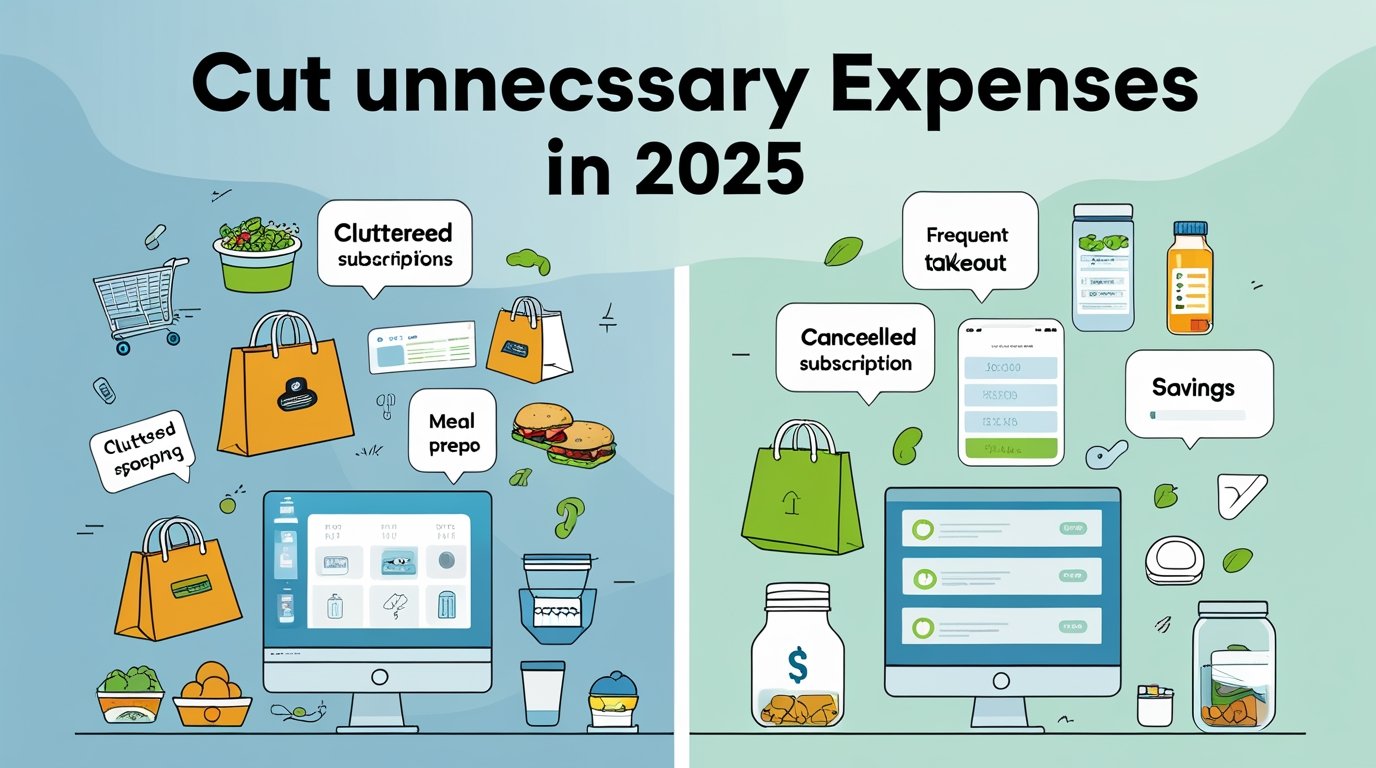Feeling like your money vanishes before the month ends? You’re not alone. In 2025, with inflation still biting and living costs rising, cutting unnecessary expenses is a must for financial freedom. Whether it’s sneaky subscriptions or impulse buys, small leaks in your budget can add up fast. The good news? You can take control with simple, actionable strategies. This article shares tips for cutting unnecessary expenses in your budget, packed with real-world examples, tools, and 2025 trends to help you save more and stress less. Let’s dive in and trim the fat from your finances!
Why Cutting Unnecessary Expenses Matters
Unnecessary expenses are those non-essential costs that don’t align with your financial goals—like that unused gym membership or daily coffee runs. Trimming these can free up cash for savings, debt repayment, or investments. In 2024, Americans spent an average of $1,200 yearly on impulse purchases (Bankrate), money that could’ve grown in a savings account.
Case Study: Sarah, a 30-year-old teacher, saved $3,000 in 2024 by canceling unused streaming services and cooking more at home, redirecting funds to her emergency savings.
How to Identify Unnecessary Expenses
Before you can cut costs, you need to spot them. Here’s how to find leaks in your budget:
1. Track Your Spending
Review bank and credit card statements for the past 3 months to see where your money goes. Use apps like Mint or YNAB (You Need A Budget) for real-time tracking.
- Tip: Categorize expenses (e.g., groceries, entertainment) to spot overspending.
2. Spot Recurring Charges
Subscriptions and memberships often fly under the radar. Look for:
- Streaming services (Netflix, Hulu)
- App subscriptions (fitness, news)
- Gym memberships
- Cloud storage plans
3. Evaluate Impulse Buys
Frequent small purchases, like takeout or online shopping, add up. Check for patterns in non-essential spending.
Suggested Visual: A pie chart showing average household spending categories (housing, food, entertainment, etc.).
Top Tips for Cutting Unnecessary Expenses in 2025
Ready to save? Here are practical strategies to slash your budget without sacrificing quality of life:
1. Review and Cancel Subscriptions
The average American spends $219 monthly on subscriptions (C+R Research, 2024). Audit yours and keep only what you use.
- Action: Use tools like Rocket Money or Trim to identify and cancel unused subscriptions.
- Example: Canceling two $15/month streaming services saves $360 yearly.
2. Cook More, Eat Out Less
Dining out costs 3-5 times more than cooking at home. Plan weekly meals to curb takeout temptation.
- Tip: Batch-cook on weekends to save time.
- Savings: Cutting two $50 restaurant meals monthly saves $1,200 annually.
3. Shop Smarter for Groceries
Grocery bills are a major expense. Save by:
- Making a list to avoid impulse buys
- Buying in bulk for staples (rice, pasta)
- Using cashback apps like Ibotta or Fetch Rewards
- Choosing store brands over name brands
Example: Switching to store brands saved one family $500 yearly (Consumer Reports).
4. Reduce Utility Bills
Energy costs are rising in 2025. Cut usage with:
- LED bulbs (save $75/year per household)
- Smart thermostats (save up to 10% on heating/cooling)
- Unplugging devices when not in use
- Shorter showers to lower water bills
Internal Link: Learn more about energy-saving hacks.
5. Limit Impulse Purchases
Online shopping makes spending too easy. Try:
- The 24-hour rule: Wait a day before buying non-essentials
- Unsubscribing from retailer emails
- Removing saved payment info from shopping sites
External Link: Consumer Financial Protection Bureau for budgeting tips.
6. Negotiate Bills
Many providers (cable, internet, phone) offer discounts if you ask. Call annually to negotiate or switch to cheaper plans.
- Example: John reduced his internet bill from $80 to $60/month, saving $240/year.
7. Use Free or Low-Cost Entertainment
Swap pricey outings for budget-friendly fun:
- Free community events (concerts, festivals)
- Library e-books and movies
- Hiking or picnics instead of theme parks
Suggested Visual: A table comparing costs of paid vs. free entertainment options.
What’s New in Budgeting for 2025?
Economic and tech trends are shaping how we save:
- AI Budgeting Tools: Apps like Cleo use AI to analyze spending and suggest cuts.
- Cashback Surge: Retailers offer bigger rewards to compete (e.g., 5% back on groceries via Rakuten).
- Subscription Bundles: Companies like Amazon and Apple combine services for lower rates.
- Micro-Savings Apps: Tools like Acorns round up purchases to save spare change.
Case Study: In 2024, a user of Qapital’s micro-savings app saved $1,800 by rounding up daily purchases to the nearest dollar.
Pros and Cons of Popular Budgeting Apps
| App | Pros | Cons |
|---|---|---|
| Mint | Free, syncs all accounts | Ads, limited customer support |
| YNAB | Goal-based budgeting, detailed reports | $14.99/month after trial |
| Rocket Money | Cancels subscriptions automatically | Premium features cost extra |
| Cleo | AI-driven insights, fun interface | Limited for complex budgets |
FAQ Section
FAQ 1: How Can I Start Cutting Expenses Without Feeling Deprived?
Start small to avoid feeling restricted. Focus on high-impact cuts like canceling unused subscriptions or reducing dining out. Replace costly habits with free alternatives, like hosting game nights instead of bar outings. Set a savings goal (e.g., $500 for a vacation) to stay motivated. Use apps like Mint to track progress without stress. Reward yourself with small treats from savings to maintain balance.
Action: List 3 expenses to cut this month and replace one with a free activity.
FAQ 2: What Are the Best Tools for Tracking Expenses?
Top tools include:
- Mint: Free, syncs accounts, and categorizes spending.
- YNAB: Helps plan every dollar for specific goals.
- PocketGuard: Shows “in-pocket” money after bills.
- Excel/Google Sheets: Free for DIY tracking.
Choose based on your needs—Mint for beginners, YNAB for detailed budgeting. Check reviews on NerdWallet to compare features.
Tip: Set aside 10 minutes weekly to review spending.
FAQ 3: How Do I Stop Impulse Buying?
Curb impulse buys by:
- Waiting 24 hours before purchasing
- Deleting shopping apps from your phone
- Using cash for in-store shopping
- Blocking retailer emails
- Shopping with a list
Identify triggers (stress, boredom) and replace shopping with hobbies like reading or exercise. Apps like Impulse Save redirect “spending urges” to savings.
Action: Try the 24-hour rule for one week and track savings.
FAQ 4: Can Negotiating Bills Really Save Money?
Yes, negotiating can save hundreds yearly. Call providers (internet, cable, insurance) and ask for discounts, loyalty rates, or cheaper plans. Mention competitor offers for leverage. Be polite but firm. In 2024, 60% of consumers who negotiated their cable bill got a lower rate (Consumer Reports).
Resource: Use scripts from The Balance to negotiate confidently.
Schema Markup for FAQs
Conclusion
Cutting unnecessary expenses in 2025 is easier than ever with smart strategies and modern tools. By tracking spending, canceling subscriptions, cooking at home, and negotiating bills, you can save thousands without sacrificing joy. Stay ahead with trends like AI budgeting apps and micro-savings. Start small, stay consistent, and watch your savings grow. What’s one expense you’ll cut this month? Share in the comments or sign up for our newsletter for more money-saving tips!

